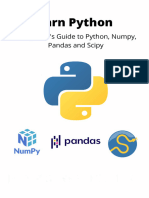0 ratings0% found this document useful (0 votes)
2 viewsSteps to install all you need to start coding with python
This document outlines the steps to install Python and set up a coding environment. It includes downloading Python, installing a code editor or IDE, verifying the installation, creating a new Python file, writing a simple code, and running it. Following these steps will enable you to start coding in Python.
Uploaded by
hajarelqacemiCopyright
© © All Rights Reserved
We take content rights seriously. If you suspect this is your content, claim it here.
Available Formats
Download as DOCX, PDF, TXT or read online on Scribd
0 ratings0% found this document useful (0 votes)
2 viewsSteps to install all you need to start coding with python
This document outlines the steps to install Python and set up a coding environment. It includes downloading Python, installing a code editor or IDE, verifying the installation, creating a new Python file, writing a simple code, and running it. Following these steps will enable you to start coding in Python.
Uploaded by
hajarelqacemiCopyright
© © All Rights Reserved
We take content rights seriously. If you suspect this is your content, claim it here.
Available Formats
Download as DOCX, PDF, TXT or read online on Scribd
You are on page 1/ 2
Steps to install all you need to start coding with python:
Download and Install Python
Visit the official Python website: https://www.python.org/downloads/
Download the latest version: Choose the appropriate installer for your operating system
(Windows, macOS, or Linux).
Run the installer: Follow the on-screen instructions to install Python on your computer.
2. Install a Code Editor or IDE
Visual Studio Code (VS Code): This is a popular and powerful code editor that offers
excellent Python support. Download it from https://code.visualstudio.com/
Other options: You can also use other code editors or integrated development
environments (IDEs) like PyCharm, Sublime Text, or Atom.
3. Verify Installation
Open your terminal or command prompt.
Type python --version and press Enter. This should display the installed Python
version.
4. Create a New Python File
Open your code editor or IDE.
Create a new file with a .py extension (e.g., hello.py).
5. Write Your First Python Code
Type the following code:
Python
print("Hello, world!")
Utilisez ce code avec précaution.
Save the file.
6. Run the Code
Open a terminal or command prompt.
Navigate to the directory where you saved the file.
Type python hello.py and press Enter. This will execute your code and print "Hello,
world!" to the console.
Now you're ready to start coding in Python!
You might also like
- Python for Beginners: A Crash Course to Learn Python Programming in 1 WeekFrom EverandPython for Beginners: A Crash Course to Learn Python Programming in 1 WeekNo ratings yet
- Python Programming : How to Code Python Fast In Just 24 Hours With 7 Simple StepsFrom EverandPython Programming : How to Code Python Fast In Just 24 Hours With 7 Simple Steps4/5 (55)
- Introduction to Python Programming: Learn Coding with Hands-On Projects for BeginnersFrom EverandIntroduction to Python Programming: Learn Coding with Hands-On Projects for BeginnersNo ratings yet
- Python for Beginners: An Introduction to Learn Python Programming with Tutorials and Hands-On ExamplesFrom EverandPython for Beginners: An Introduction to Learn Python Programming with Tutorials and Hands-On Examples4/5 (2)
- Comment Débuter Avec Python - Comment Coder en PythonNo ratings yetComment Débuter Avec Python - Comment Coder en Python6 pages
- Setting Up A Python Development EnvironmentNo ratings yetSetting Up A Python Development Environment2 pages
- New Dou-Csc111 Introduction To Programing - Python February 2024No ratings yetNew Dou-Csc111 Introduction To Programing - Python February 2024152 pages
- Python for Beginners: Learn the Fundamentals of Computer ProgrammingFrom EverandPython for Beginners: Learn the Fundamentals of Computer ProgrammingNo ratings yet
- Python and VS Code Installation On WindowsNo ratings yetPython and VS Code Installation On Windows9 pages
- E22 - Lecture 3 - Notes - Python Basics_3c679fc57499154f4d8f12cb3f2bd3ddNo ratings yetE22 - Lecture 3 - Notes - Python Basics_3c679fc57499154f4d8f12cb3f2bd3dd14 pages
- Python by Example Book 1 (Fundamentals and Basics)100% (1)Python by Example Book 1 (Fundamentals and Basics)57 pages
- OneCampus - Python Programming TextbookNo ratings yetOneCampus - Python Programming Textbook263 pages
- Lab 1 Introduction To Python ProgrammingNo ratings yetLab 1 Introduction To Python Programming11 pages
- Kumar, Kishore - Learn Python - A Beginner's Guide To Python, Numpy, Pandas and Scipy (2021)No ratings yetKumar, Kishore - Learn Python - A Beginner's Guide To Python, Numpy, Pandas and Scipy (2021)348 pages
- Python Programming: 8 Simple Steps to Learn Python Programming Language in 24 hours! Practical Python Programming for Beginners, Python Commands and Python LanguageFrom EverandPython Programming: 8 Simple Steps to Learn Python Programming Language in 24 hours! Practical Python Programming for Beginners, Python Commands and Python Language2/5 (1)
- Python Primer: Patrice Koehl Modified by Xin Liu in Apr., 2011No ratings yetPython Primer: Patrice Koehl Modified by Xin Liu in Apr., 201133 pages
- Introduction to Python Programming A Step-by-Step GuideNo ratings yetIntroduction to Python Programming A Step-by-Step Guide1 page
- Python Programming: A Hands-On Guide: Hello World E-books STEM, #1From EverandPython Programming: A Hands-On Guide: Hello World E-books STEM, #1No ratings yet
- 11 Lecture Note Unit 1 Program Structure Pcps 2023No ratings yet11 Lecture Note Unit 1 Program Structure Pcps 20235 pages
- Python Primer - A Self Study Approach by Bibek BhandariNo ratings yetPython Primer - A Self Study Approach by Bibek Bhandari89 pages



























































